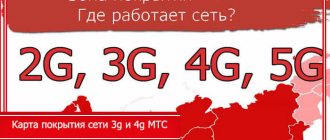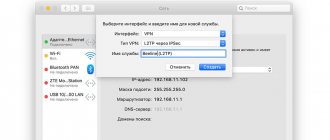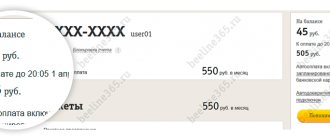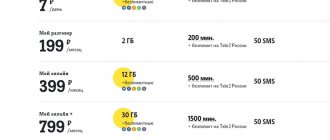Beeline coverage map and its features
Having studied the map of the location of the operator’s communication towers, you can see that the entire country is covered by them. But communication is not always present where there are well-equipped mobile operator stations. Why so, you ask.
Many users who do not know about the features of mobile communications attribute problems with it to the service operator. But this is far from true.
Network quality depends on many factors:
- Insufficient signal emission power from the base tower or incorrect direction of the antennas.
- Uneven distribution of base stations due to the peculiarities of the geographical location and architectural development of the settlement, resulting in incomplete coverage of the territory.
- The quality of communication also depends on the density of the area , the layout of the building in which the subscriber is located, or even on the thickness of its walls.
- Weather conditions play an important role - for example, rain greatly affects the throughput of communication channels.
Basically, the subscriber wants to know about the quality of communication and coverage area in the following cases :
- Buying real estate (most often outside the city).
- When going on a trip, picnic or vacation.
- Going on a business trip.
How to use the card
To find out whether operator services are available in the region and how strong the signal from the towers is, you need to open the map. For the system to automatically detect your location, you must allow the site to synchronize your device with geodata. Next, you just have to select your operator and connection option.
On the presented map you can see data on the cellular coverage area of the following operators:
- MTS.
- Megaphone.
- Beeline.
- Tele 2.
- Iota.
- TinkoffMobile.
- TTK mobile.
- Sbermobile.
- Kramtelecom.
- Rostelecom, etc.
Additionally, you can select cellular generations to view their coverage areas:
- 2G.
- 3G.
- 4G.
In some regions, one or another operator may not be available.
Disadvantages of the card
Data on coverage areas of cellular operators on the map are provided by the companies themselves. The result is errors that can be seen in sparsely populated areas. An organization can guarantee 4G in forests, villages and dachas, but in reality the user will have access to 2G Internet or only cellular communications for making calls.
Inaccuracies arise as a result of terrain calculations using special programs that take into account the terrain, station locations and antenna heights. Next, the system determines where the signal will be strong and where it will be weak.
Some terrain elements are also not taken into account in the calculation process. Building density, tree height, house material and other parameters affect the quality of cellular communications. Depth also affects the signal. If the user is in the basement, it will be difficult to connect to high-speed Internet.
Where can I get 3g and 4g signals from Beeline?
Having carefully studied the Beeline coverage map, you will notice that the Internet of these categories is not available everywhere. The best signals of 3g technology can be received in the central part of the country, but in the eastern and northern regions the situation is worse.
Regarding the Internet using 4g technology, the coverage here is much more modest. Base stations with this signal are located pointwise, which means that not all operator users can receive the signal.
4g Internet can be used by residents of the Moscow and St. Petersburg megacities, as well as their regions. Residents of certain central regions of Russia also have this advantage.
In other regions of the Russian Federation, 4g signals appear only in the largest cities - administrative centers of the regions where Beeline LTE base stations are located. This service is provided in 11 regions of the country, increasing its volume to cover more and more new territories every year.
3G/4G Internet signal coverage areas of Tula and the Tula region
This page contains links to 3G/4G coverage maps from mobile operators in the Tula region.
Wireless Internet from mobile operators covers almost all corners of Tula and the Tula region. But the signal strength of all operators varies quite a lot depending on the distance from the base station. Therefore, it is advisable, before purchasing a 3G/4G modem, to clarify the exact wireless Internet coverage area at the point of desired use.
The use of 3G/4G technology to access the worldwide network significantly increases the capabilities of Internet users. But the use of this type of connection does not always provide a strong and stable Internet signal. You can find out how to solve this problem on our website online.
The following are links to 3G/4G network coverage maps for the Tula region:
There are separate 3G and 4G bookmarks on the MTS card. At the same time, it is very convenient to differentiate the UMTS900 and UMTS2000 standards by color in the 3G tab, which subsequently greatly facilitates the selection of an antenna for signal amplification.
Everything is simple on Beeline’s map. There is a certain advantage compared to maps of other operators - you can immediately see the coverage of the central part of Russia, without switching regions.
On the Megafon map, 3G and 4G coverage is immediately visible on one tab. 4G coverage essentially coincides with the coverage of the Yota network, because relatively recently Megafon bought Yota
.For reference, 3G technology in practice produces speeds of 0.5 - 10 Mbit/s, and 4G technology 10-20 Mbit/s. At the same time, the 4G coverage area is tens of times smaller than that of 3G, because... 4G technology began to develop much later.
Internet everywhere is:
Quality equipment
Optimally selected and proven equipment from the best domestic and foreign manufacturers
High internet speed
Speed up to 100 Mbit/s
Low cost
From 490 RUR/month and the possibility of freezing up to 90 days a year thanks to exclusive tariff plans
Promotion "Spring discounts"
Apply today and start using high-speed Internet at a reduced price tomorrow.
Articles
Connect the Internet and TV at the dacha
Interactive television in a private home
Connect Internet and television in the village
Internet television in a private house
Tula, st. Frunze 4A, off. 207
Internet Everywhere Kit
Router
Description ZBT WE1626
“The ZBT company has adopted the successful experience of its competitors and released a router that is in many ways similar to the popular Zyxel Keenetic Omni II and Keenetic 4G. Like products from a more famous manufacturer, the ZBT WE1626 Router automatically “picks up” almost all popular USB modems, including branded operator models, as well as numerous popular models from Huawei, ZTE and other manufacturers. There is a Ping Check mode for constantly checking the presence of an Internet connection and automatically rebooting the 3G4G modem if it freezes."
Description TL-WR842N
The multifunctional Wi-Fi router TL-WR842N has Wi-Fi speeds of up to 300 Mbps and provides fast data transfer, reliable HD video streaming, as well as online games and Skype calls without disconnection. The router can be connected to desktop computers; for this purpose it is equipped with appropriate LAN ports (4 ports). Two powerful 5 dBi antennas allow you to cover a wide area (up to 150 square meters) and create high quality and speed of data transmission. Operates at a frequency of 2.4 GHz.
Wi-Fi router ZyXEL Keenetic Extra
Works without failures or freezing when paired with Antennas and Internet signal amplifiers. There is a function to reboot a frozen modem and Internet signal amplifier using power, which allows you to independently restore the communication channel without the participation of a specialist. This is especially important if we are talking about a remote facility (office, warehouse, cottage). Four powerful 5 dBi antennas allow you to dig a large area (up to 300 square meters) and create high quality and speed of data transmission. It operates in two bands at frequencies of 2.4 GHz and 5 GHz.
What is 4G technology
4G is a newer method of receiving and transmitting network data. Distinctive features:
- Bandwidth of more than 100 Mbps for moving devices;
- More than 1 Gbit per second for fixed subscribers.
The technology meets the following parameters:
- Use of IP protocols;
- Bandwidth up to 40 MHz;
- High quality work;
- Dynamic partitioning to optimize performance;
- Bandwidth for devices moving at 33.3 meters per second.
Above is an interactive map of Beeline 4G coverage and the differences between the network and 3G below. The site also has automatic Internet settings for Android.
Features of 4G from Beeline
When purchasing a phone or tablet, you need to make sure. That it supports 4G format. To do this, it is recommended to use the official portal of the Beeline company, where there is a list of all the gadgets used. You should change the SIM card to the new usim format.
This manipulation is implemented in branded communication shops. This operation is available only to the account owner, and you will need to present a passport or driver's license. It will be possible to enable unlimited internet on the number.
Difference between 3G and LTE
Both data transfer formats are available to users in Russia, the difference lies in the download speed and coverage area. Let's look at how the standards differ:
- The third generation 3G format provides consumers with an Internet connection at a speed of 10 MB per second. LTE has -100 MB per second.
- The standards operate at different frequencies from 900 to 2100 MHz, from 1800 to 2600 MHz, respectively.
- LTE Beeline has a significant drawback. The format has 20% more energy compared to 3G.
The higher the frequency range, the lower the reception area. 3G is the most widespread.
Quality
Smartphones are evolving rapidly; they have become a part of the life of modern people. Modern users pay attention:
- Cameras.
- Design.
- What are the options?
Beeline's service covers users in a wide variety of regions, including the most remote ones. Beeline coverage area is not always uniform; the quality of stable communication is influenced by several factors. The antenna is not pointed correctly.
In this case, different levels of repeaters arise, the signal itself noticeably weakens, losing its power. The towers are positioned incorrectly, this may be caused by the landscape or the presence of a large number of objects created from reinforced concrete.
The signal is also affected by the density of buildings, so in a metropolis, communication problems may also arise in certain areas.
2G technology
The 2G standard was a revolutionary breakthrough. Mobile communications began to work fully with the advent of digital equipment. Channels began to be used more efficiently, the speed increased by an order of magnitude (compared to analogue technology). In the 2G network, the speed reached 16 kbit/s, that is, it became possible to transmit short texts (SMS).
The main contribution of the GSM standard was support for SIM cards. The frequency used was (895–965 MHz). After a short time the following frequencies were also used:
- 1720 – 1890 MHz;
- 825 – 895 MHz
- 1855 – 1996 MHz (US standard).
3G technology
Another major step was the emergence of CDMA (Code Division Multiple Access) technology. What distinguished it from the GSM standard was that the channels were used more intensively. The quality of communication, beeline coverage, largely depends on the location of base stations and how modern equipment is present on them.
While 3G prevails in the central regions of the country, in the Far East and in the regions of Siberia it does not work equally successfully everywhere.
It often happens (especially in the northern regions of Siberia) when the base station is located at a considerable distance, but the level of communication there can be excellent. The signal is transformed and reflected as it passes, and its “behavior” is sometimes impossible to predict.
The official Beeline portal provides complete data on the regions in which the 3G standard operates; now it covers almost the entire huge country.
4G technology
Cellular towers are scattered throughout Russia, and the transition to the 4G standard is currently taking place at a rapid pace. Thus, in the near future, Beeline subscribers will have stable communications around the clock in all points of the country, Beeline 4g coverage area will be one hundred percent.
To attract subscribers, the operator continues to install new equipment on base towers; data transmission will be possible at speeds of up to one hundred megabits per second.
Beeline LTE technology is also being actively implemented, this will allow active operation at a frequency of 900 MHz. This a priori makes it possible for Beeline to become a leader among the Big Three.
The company plans to begin installing 5G equipment in the near future. The signal transmission speed will increase by 2.5-3 times. (up to 300 Mb/sec). 5G will launch in the first half of this year.
Beeline coverage area and its features
The coverage area is of interest to people who live in places remote from large cities or who often travel outside the city on vacation.
Beeline's coverage area on a map of Russia is presented on the operator's website. The locations of the towers and their range of action are marked there. Having studied the map, you can see that a very large part of the country is covered by Beeline towers, but there is not always communication near the equipped stations.
Beeline coverage area - map of Russia
Often users attribute problems that arise with mobile communications to the servicing operator. This is not always true. Network quality depends on the following factors:
- Weak power from the tower signal or incorrect direction of the antennas.
- Geographical features of the area and the development of a populated area, where uniform distribution and installation of mobile operator towers is impossible.
- The density of urban development and the thickness of walls, which affect the signal level and communication quality.
- Weather. It was revealed that in the rain the communication throughput is noticeably lower.
The highest communication signal and Internet speed are in big cities and metropolitan areas. In remote settlements the situation is different. Although there may not be a tower in this area, your phone will still pick up a low signal. More often this occurs due to a reflected signal.
Network Action Map
Operator towers are arranged in layers. The provider installed 2G/3G/4G/4G+ networks by overlaying sources on top of each other. The coverage radius of 1 antenna is 1.13 km2 at a source frequency of 2,600 MHz and 4.52 km2 at 800 MHz. This means that the Beeline LTE zone coverage map provides a range of coverage 4 times greater than when using standard high-speed towers.
The quality of the connection depends on:
- from the general layout of the area;
- source localization;
- specifics of the terrain.
Speed is also affected by weather conditions. Accordingly, the Beeline 3G and 4G coverage area map in Russia does not guarantee the availability of a network in a certain geographic location. When connecting a large number of receivers to one source, the quality and speed of information transfer decrease.
3G coverage area
3G – high-speed mobile Internet. It is included in the operator's service package at basic rates. The connection is provided within all populated areas. 3G is available for smartphones and tablets. Tariffs are charged based on megabytes consumed when connecting. The provider provides several packages with 3G within the #EVERYTHING is possible. High-speed connections are available for tablets and computers.
3G is also provided in archived tariffs. Depending on the service package, high-speed Internet traffic is 100 MB, 1 GB, 4 GB and 5 GB. Megabyte consumption is limited to the territory of the home network. Connection speed does not affect MB consumption.
Geographically, the 3G network covers 80% of cities in Russia. High speed connection is available thanks to antennas. They are placed at the same distance from each other. The signal is transmitted within the communication range.
There are towers all over Russia. You can see the location of access points on the 3G coverage map from Beeline. All sources are marked with geolocation. 3 G is marked in yellow. Problems with connection are observed only in villages remote from the central part of the country.
High speed internet 4G
Mobile technologies have advanced, and now many operators, in particular Beeline, provide better connections. Ultra-high-speed Internet is called 4G. The 4G coverage area from Beeline is shown dotted. The main part of the towers is located in the central regions: Moscow and the Moscow region, St. Petersburg and nearby regions (Oryol, Tula, Ryazan, etc.).
LTE Beeline base stations are installed only in large cities. The service is available in 11 regions of the country. The scope of coverage of territories increases every year.
The difference between 3G and 4G is the speed of downloading information. When connected to a 3G tower, loading a website page takes 3-4 seconds, while 4G does it instantly. Recently, the operator has been distributing the latest generation of 4G+ mobile Internet. It is available only in Moscow.
Grand total
In order to be connected, users need to have an idea of the quality of communication in the area where they are located. To do this, the Beeline operator has posted a very accessible map of its network coverage on its website. If the subscriber is not satisfied with the signal quality, the company is always ready to listen and help solve the problem. In addition, today the solution to many connection problems is not limited to adjusting antennas at base stations, but you can find out exactly what solutions to problems exist in this article.
Where can you catch 3G and 4G signals from Beeline
3G and 4G signals reach their maximum levels near large populated areas. Residents of the European part of the country, Moscow and the region have constant, stable access to the network space. The situation gets worse on the eastern side of the map. Cellular communications and mobile Internet are available only in cities.
Quality parameters
In fact, the access speed and signal quality may differ from those declared by the operator. Let's consider the reasons affecting the network distribution parameters:
- High load on the provider's station (BS).
- Bad weather conditions.
- Unique landscape and architectural features.
- Features of the emitter and its power.
- The number of base towers located around the consumer and their distance.
All this affects the quality and level of signal reception.
What to do if there is no high-quality signal reception?
speed 3g-4g beeline
The presence of regions with insufficient 3G and 4G coverage is not always the fault of the mobile operator. It makes no sense to express dissatisfaction with the insufficient speed of implementation of fixed stations, or with the lack of capacity of existing stations. This will only create a negative information background, but will not speed up the commissioning of new stations, nor will it help with the technical renovation of existing installations. The right solution would be to send a request to Beeline, which will indicate the territorial location of the subscriber. The mobile operator will definitely take into account the client’s request and analyze the technical feasibility of providing mobile communication services in the specified location. If necessary, make appropriate adjustments to the settings. Such feedback from the subscriber is extremely important for the mobile operator, as it makes it possible to control the quality of the services provided.
It should be taken into account that the problem may also be as follows: a mobile phone, due to its technical characteristics, is not capable of receiving a signal of this format. You can find out more information in the instructions that came with your smartphone. Or, get advice from a specialist at the mobile device sales office.
Peak load moments are an additional factor for poor signal transmission. If necessary, the subscriber can use cellular amplifiers if no other solution is found.
Recommended viewing:
Signal problems and solutions
Unfortunately, if you are located at a considerable distance from base stations or in remote settlements, then you will not be able to fix the quality of cellular communications yourself. All this depends on the operator himself and the modernization of the equipment.
To minimize problems, the following is recommended:
- Try to go to an open area so that concrete floors and hills do not obstruct the signal.
- Install an additional amplifier on your home Internet router.
- Try to use data services in the evening, when the load on base stations drops.
- Change your tariff plan or choose a different provider.
Beeline is gradually developing technologies and expanding into new localities, so users can try the operator’s services in almost all localities in Russia and not worry about the quality of communication.
What are the reasons?
Sometimes the signal coverage of the Beeline network can “work” unpredictably and there are reasons for this. If the subscriber is on a mountain pass or hillside, then the reflection of the impulses can occur along a complex trajectory.
The nature of electromagnetic waves is quite well studied, but questions still remain. It is not possible to predict 100% successful signal transmission in areas with difficult terrain.
Sources
- https://pro-beeline.com/uslugi/zona-pokrytiya
- https://antenna1.ru/services/sotovaya-svyaz-i-internet/karta-i-zona-pokrytiya-mts-bilayn-megafon-yota-gsm-3g-lte-4g-region-name/
- https://beelinex.ru/zona-pokrytiya-4g/
- https://beeline77.ru/bilayn-zona-pokrytiya/
- https://beelinehelp24.ru/rouming/zona-pokrytiya
- https://4gconnect.ru/zona-pokrytiya-bilajn
Signal reception problems and how to solve this problem
As mentioned above, the absence of a signal or its poor quality occurs everywhere. And the operator is not always the reason for this. Now we would like to tell you what you can do if you have a bad operator signal on your phone.
Of course, complaining about a small number of base stations or their insufficient power will not speed up the process of installing new ones or upgrading old ones.
But by sending a request to the operator indicating your location and the characteristics of the signal you are receiving, you can be sure that the operator will definitely consider this request and check the settings of its stations in this region, which may simply need additional correction. That is why feedback from its users is very important for Beeline.
In addition, the problem may lie in the gadget itself, which simply does not receive a signal due to the fact that it does not support this type of communication. To avoid this, when purchasing equipment, be sure to ask the seller about the functions of receiving communication signals.
To solve connection problems in remote areas of the region where the signal does not penetrate well, such as in the country, you can install special cellular amplifiers.
It is also worth paying attention to the time of registration on the network. The fact is that during peak hours, when the network experiences a large influx of users, the signal scatters and there simply may not be enough for everyone, or its quality begins to “limp”.
It will be useful to view:











